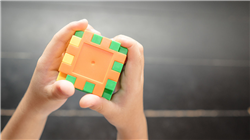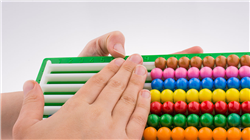University certificate
The world's largest faculty of education”
Introduction to the Program
You have at your disposal the best program in the current educational market to delve into the development of arithmetic and numeracy skllls, through dozens of hours of theoretical and practical content”

Mathematics and its component branches represent a challenge of understanding for the student, and of teaching for the professional. Its understanding must be approached from the first school levels to avoid that famous difficulty that characterizes it. A solid initial base explained through numerical games and advanced methodologies will lay the foundations for a fluid learning process.
Therefore, the teacher specialized in this area needs constant updating and continuous improvement of their skills when transmitting knowledge to their own students. In this context, TECH has created this Postgraduate certificate, whose objective is to enable students to update their skills in the teaching of numeracy in Pre-school Education. This way, through a 100% online methodology that allows you to manage your study schedules according to your needs and obligations, the student will obtain an efficient learning and will acquire the necessary skills to advance towards an informal and intuitive arithmetic in Pre-school Education.
To do so, they will have 150 hours of the best theoretical and practical content, which they will be able to access at any time and place, only needing a device with an internet connection. In addition, you will have at your disposal a large amount of complementary material in the form of detailed videos, dynamic summaries of each unit, complementary readings, frequently asked questions and much more, which will help you to boost your career and position yourself as an expert in a high-demand sector.
Delve into the stages in the teaching-learning of magnitudes and boost your professional career thanks to this Postgraduate certificate”
This Postgraduate certificate in Arithmetic, Algebra, Geometry, and Measurement in Pre-School Education.Number Games contains the most complete and up-to-date educational program on the market. The most important features include:
- The development of practical cases presented by experts in Arithmetic, Algebra, Geometry and Measurement. in Pre-School
- The graphic, schematic, and practical contents with which they are created, provide practical information on the disciplines that are essential for professional practice
- Practical exercises where the self-assessment process can be carried out to improve learning
- Its special emphasis on innovative methodologies
- Theoretical lessons, questions to the expert, debate forums on controversial topics, and individual reflection assignments
- Content that is accessible from any fixed or portable device with an Internet connection
Enroll now and delve into the development of pre-linguistic numerical skills in pre-school education”
The program’s teaching staff includes professionals from the sector who contribute their work experience to this training program, as well as renowned specialists from leading societies and prestigious universities.
The multimedia content, developed with the latest educational technology, will provide the professional with situated and contextual learning, i.e., a simulated environment that will provide immersive education programmed to learn in real situations.
The design of this program focuses on Problem-Based Learning, by means of which the professional must try to solve the different professional practice situations that are presented throughout the academic course. For this purpose, the students will be assisted by an innovative interactive video system created by renowned and experienced experts.
An unique opportunity to establish comparison of counting concepts in Piaget’s, Gelman’s and Gallistel’s Theory"

Take advantage of all the tools offered by this Postgraduate certificate and access them 24 hours a day, establishing your own pace of study"
Why study at TECH?
TECH is the world’s largest online university. With an impressive catalog of more than 14,000 university programs available in 11 languages, it is positioned as a leader in employability, with a 99% job placement rate. In addition, it relies on an enormous faculty of more than 6,000 professors of the highest international renown.

Study at the world's largest online university and guarantee your professional success. The future starts at TECH”
The world’s best online university according to FORBES
The prestigious Forbes magazine, specialized in business and finance, has highlighted TECH as “the world's best online university” This is what they have recently stated in an article in their digital edition in which they echo the success story of this institution, “thanks to the academic offer it provides, the selection of its teaching staff, and an innovative learning method aimed at educating the professionals of the future”
A revolutionary study method, a cutting-edge faculty and a practical focus: the key to TECH's success.
The most complete study plans on the university scene
TECH offers the most complete study plans on the university scene, with syllabuses that cover fundamental concepts and, at the same time, the main scientific advances in their specific scientific areas. In addition, these programs are continuously being updated to guarantee students the academic vanguard and the most in-demand professional skills. In this way, the university's qualifications provide its graduates with a significant advantage to propel their careers to success.
TECH offers the most comprehensive and intensive study plans on the current university scene.
A world-class teaching staff
TECH's teaching staff is made up of more than 6,000 professors with the highest international recognition. Professors, researchers and top executives of multinational companies, including Isaiah Covington, performance coach of the Boston Celtics; Magda Romanska, principal investigator at Harvard MetaLAB; Ignacio Wistumba, chairman of the department of translational molecular pathology at MD Anderson Cancer Center; and D.W. Pine, creative director of TIME magazine, among others.
Internationally renowned experts, specialized in different branches of Health, Technology, Communication and Business, form part of the TECH faculty.
A unique learning method
TECH is the first university to use Relearning in all its programs. It is the best online learning methodology, accredited with international teaching quality certifications, provided by prestigious educational agencies. In addition, this disruptive educational model is complemented with the “Case Method”, thereby setting up a unique online teaching strategy. Innovative teaching resources are also implemented, including detailed videos, infographics and interactive summaries.
TECH combines Relearning and the Case Method in all its university programs to guarantee excellent theoretical and practical learning, studying whenever and wherever you want.
The world's largest online university
TECH is the world’s largest online university. We are the largest educational institution, with the best and widest online educational catalog, one hundred percent online and covering the vast majority of areas of knowledge. We offer a large selection of our own degrees and accredited online undergraduate and postgraduate degrees. In total, more than 14,000 university degrees, in eleven different languages, make us the largest educational largest in the world.
TECH has the world's most extensive catalog of academic and official programs, available in more than 11 languages.
Google Premier Partner
The American technology giant has awarded TECH the Google Google Premier Partner badge. This award, which is only available to 3% of the world's companies, highlights the efficient, flexible and tailored experience that this university provides to students. The recognition as a Google Premier Partner not only accredits the maximum rigor, performance and investment in TECH's digital infrastructures, but also places this university as one of the world's leading technology companies.
Google has positioned TECH in the top 3% of the world's most important technology companies by awarding it its Google Premier Partner badge.
The official online university of the NBA
TECH is the official online university of the NBA. Thanks to our agreement with the biggest league in basketball, we offer our students exclusive university programs, as well as a wide variety of educational resources focused on the business of the league and other areas of the sports industry. Each program is made up of a uniquely designed syllabus and features exceptional guest hosts: professionals with a distinguished sports background who will offer their expertise on the most relevant topics.
TECH has been selected by the NBA, the world's top basketball league, as its official online university.
The top-rated university by its students
Students have positioned TECH as the world's top-rated university on the main review websites, with a highest rating of 4.9 out of 5, obtained from more than 1,000 reviews. These results consolidate TECH as the benchmark university institution at an international level, reflecting the excellence and positive impact of its educational model.” reflecting the excellence and positive impact of its educational model.”
TECH is the world’s top-rated university by its students.
Leaders in employability
TECH has managed to become the leading university in employability. 99% of its students obtain jobs in the academic field they have studied, within one year of completing any of the university's programs. A similar number achieve immediate career enhancement. All this thanks to a study methodology that bases its effectiveness on the acquisition of practical skills, which are absolutely necessary for professional development.
99% of TECH graduates find a job within a year of completing their studies.
Postgraduate Certificate in Arithmetic, Algebra, Geometry and Measurement in Early Childhood Education. Play with Numbers
Have you ever wondered how to awaken the love for mathematics in the little ones? The Postgraduate Certificate in Arithmetic, Algebra, Geometry and Measurement in Early Childhood Education: Play with Numbers is your chance to make a difference! Discover the virtual modality that the prestigious Faculty of Education of TECH Global University has for you, and immerse yourself in a 6-week journey full of knowledge and creativity. How would you like to explore the fascinating world of numbers through games and interactive activities? In this innovative course, you will be immersed in a cutting-edge virtual environment designed to awaken children's curiosity and interest in mathematics from an early age. Can you imagine teaching them to add, subtract and multiply in a fun and effective way?
What about teaching them to add, subtract and multiply in a fun and effective way?
Get ready to inspire the next generation of brilliant mathematical minds with TECH
.
Our team of experts will guide you on this exciting journey, providing you with solid pedagogical tools and creative teaching strategies. You will learn how to use visual and manipulative resources to teach abstract concepts such as algebra and geometry. The virtual environment in which the course takes place will give you access to up-to-date study materials, supplementary resources and interactive activities designed to reinforce your understanding and apply your knowledge in practical cases. Would you like to see your students build geometric solids with their own hands and solve equations like real mathematicians? The 6-week duration will allow you to explore each subject area in depth, giving you plenty of time to assimilate the knowledge and put it into practice. Are you ready to become a teacher of mathematics in early childhood education? By the end of the Course, you will have acquired a wide range of skills that will enable you to be an exceptional teacher in the field of mathematics in early childhood education.Don't miss this unique opportunity to transform the way children view mathematics.
"







